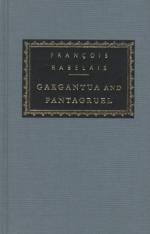But other Italian sources are absolutely certain. There are few more wonderful chapters in Rabelais than the one about the drinkers. It is not a dialogue: those short exclamations exploding from every side, all referring to the same thing, never repeating themselves, and yet always varying the same theme. At the end of the Novelle of Gentile Sermini of Siena, there is a chapter called Il Giuoco della pugna, the Game of Battle. Here are the first lines of it: ’Apre, apre, apre. Chi gioca, chi gioca —uh, uh!—A Porrione, a Porrione.—Viela, viela; date a ognuno.—Alle mantella, alle mantella.—Oltre di corsa; non vi fermate.—Voltate qui; ecco costoro; fate veli innanzi.—Viela, viela; date costi.—Chi la fa? Io—Ed io.—Dagli; ah, ah, buona fu.—Or cosi; alla mascella, al fianco. —Dagli basso; di punta, di punta.—Ah, ah, buon gioco, buon gioco.’
And thus it goes on with fire and animation for pages. Rabelais probably translated or directly imitated it. He changed the scene; there was no giuooco della pugna in France. He transferred to a drinking-bout this clatter of exclamations which go off by themselves, which cross each other and get no answer. He made a wonderful thing of it. But though he did not copy Sermini, yet Sermini’s work provided him with the form of the subject, and was the theme for Rabelais’ marvellous variations.
Who does not remember the fantastic quarrel of the cook with the poor devil who had flavoured his dry bread with the smoke of the roast, and the judgment of Seyny John, truly worthy of Solomon? It comes from the Cento Novelle Antiche, rewritten from tales older than Boccaccio, and moreover of an extreme brevity and dryness. They are only the framework, the notes, the skeleton of tales. The subject is often wonderful, but nothing is made of it: it is left unshaped. Rabelais wrote a version of one, the ninth. The scene takes place, not at Paris, but at Alexandria in Egypt among the Saracens, and the cook is called Fabrac. But the surprise at the end, the sagacious judgment by which the sound of a piece of money was made the price of the smoke, is the same. Now the first dated edition of the Cento Novelle (which were frequently reprinted) appeared at Bologna in 1525, and it is certain that Rabelais had read the tales. And there would be much else of the same kind to learn if we knew Rabelais’ library.
A still stranger fact of this sort may be given to show how nothing came amiss to him. He must have known, and even copied the Latin Chronicle of the Counts of Anjou. It is accepted, and rightly so, as an historical document, but that is no reason for thinking that the truth may not have been manipulated and adorned. The Counts of Anjou were not saints. They were proud, quarrelsome, violent, rapacious, and extravagant, as greedy as they were charitable to the Church, treacherous and cruel. Yet their anonymous panegyrist has made them patterns of all




